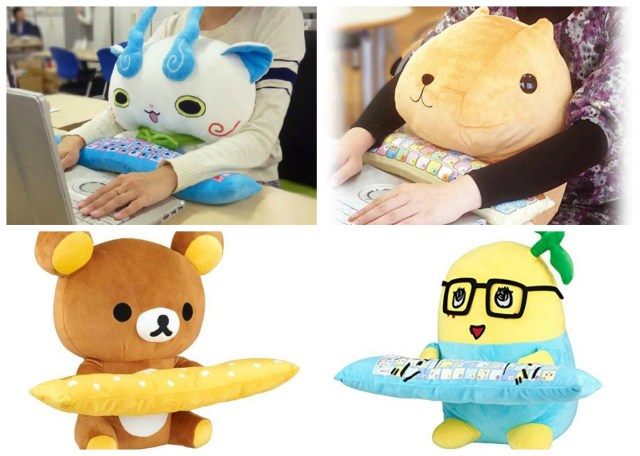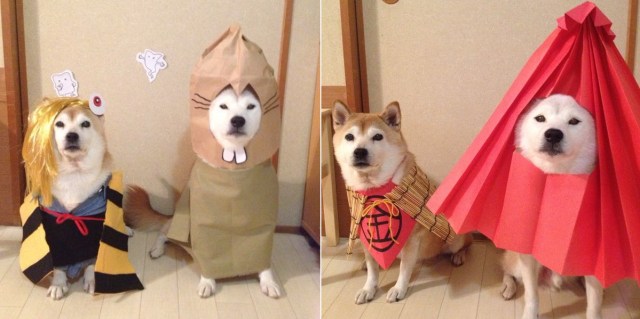Japan’s most terrifying ghouls, monsters and demons come out to frighten the public on a street believed to border the spirit world.
yokai (Page 2)
The granddaddy of yokai anime, Gegege no Kitaro, gets an unexpected salute as it reaches the half-century milestone.
Why DO kappa flip their lids for cucumber? No better time to investigate that than June 14, recognized around the globe as Cucumber Day.
The Kappa is generally known as a clownish, mostly friendly water spirit in Japanese mythology, but a cursory web search recently revealed the creature’s darker nature.
Haunted by demanding ghosts but can’t afford to look like a dweeb? These tights are just what you need!
What could be scarier than looking in a mirror and seeing a demon staring back at you? How about being too engrossed in your smartphone to even notice…
Even the pets of Japan want to show their respects to the recently passed yokai author Shigeru Mizuki.
See this tanuki? Aren’t his balls cute? Welcome to Japan, where raccoon-dog genitals are universally admired.
The zashikiwarashi is a Japanese child spirit that’s supposed to bring good luck, and it’s supposedly been caught on video!
We’ve been telling our fine readers for literally years now about Yo-kai Watch, the Pokémon-esque game/manga/anime series that’s full of adorable yet mischievous collectible yokai monsters. And now that the series has been newly localised and adapted for the West, you’re finally going to see for yourselves what’s been driving Japanese kids to ritually torch bonfires of old Pokémon goods in favour of worshipping the new yokai overlords. Okay, we’re exaggerating, but only a little bit.
Of course, the success of any Japanese import into the Western market hinges on a heartfelt and thorough localisation process. It happened to Pokémon—Satoshi became Ash Ketchum, and many Pokémon were entirely renamed—and now it’s happening to Yo-kai Watch, too.
But is the very Japanese charm of the new franchise about to be seriously lost in translation?
In the mid-nineteenth century, a showman named P. T. Barnum exhibited an oddity named the Fiji mermaid. Barnum’s mummified mermaid, one of the most famous hoaxes of all time, is widely believed to have been the body of a young monkey sewn onto a fish tail, and had been bought from Japanese sailors for $6,000.
Ningyo (Japanese mermaids – the word literally means “person-fish”) have a long and interesting history, but they aren’t the only ancient fake taxidermy on show in Japan. Across the country are all kinds of other fascinating specimens: “mummies” of tengu, kappa and even dragons.


















 Japan may add Japanese language proficiency, lifestyle classes to permanent foreign resident requirements
Japan may add Japanese language proficiency, lifestyle classes to permanent foreign resident requirements Disillusionment at Tsukiji’s tourist-target prices led us to a great ramen restaurant in Tokyo
Disillusionment at Tsukiji’s tourist-target prices led us to a great ramen restaurant in Tokyo Lacquerware supplier to emperor of Japan and Pokémon team up for new tableware
Lacquerware supplier to emperor of Japan and Pokémon team up for new tableware “Bear” voted Japan’s Kanji of the Year for 2025 in extremely close race
“Bear” voted Japan’s Kanji of the Year for 2025 in extremely close race Japan’s first genderless, two-piece school swimsuits are now available for adoption by schools
Japan’s first genderless, two-piece school swimsuits are now available for adoption by schools A trip to the other side of Matsushima, a mysterious power spot with an otherworldly atmosphere
A trip to the other side of Matsushima, a mysterious power spot with an otherworldly atmosphere Large amount of supposed human organs left in Osaka marketplace
Large amount of supposed human organs left in Osaka marketplace A Japanese dating app matched our bachelorette with a Buddhist monk, and she learned some things
A Japanese dating app matched our bachelorette with a Buddhist monk, and she learned some things Starbucks Japan releases new zodiac chilled cup drink for 2026
Starbucks Japan releases new zodiac chilled cup drink for 2026 Starbucks teams up with the oldest of Japan’s Six Ancient Kilns to create a Bizen ware coffee mug
Starbucks teams up with the oldest of Japan’s Six Ancient Kilns to create a Bizen ware coffee mug 7-Eleven Japan starts new temporary luggage storage service in over 300 branches
7-Eleven Japan starts new temporary luggage storage service in over 300 branches Starbucks teams up with 166-year-old Kyoto doll maker for Year of the Horse decorations【Photos】
Starbucks teams up with 166-year-old Kyoto doll maker for Year of the Horse decorations【Photos】 Tokyo’s Tsukiji sushi neighborhood asks tour groups to stay away for the rest of the month
Tokyo’s Tsukiji sushi neighborhood asks tour groups to stay away for the rest of the month Street Fighter Hadouken Churros to be launched and eaten in Tokyo, Okami pudding on offer too
Street Fighter Hadouken Churros to be launched and eaten in Tokyo, Okami pudding on offer too Japanese woman mistaken for bear
Japanese woman mistaken for bear Return of Totoro sequel short anime announced for Ghibli Park
Return of Totoro sequel short anime announced for Ghibli Park Is this the most relaxing Starbucks in Japan?
Is this the most relaxing Starbucks in Japan? Starbucks on a Shinkansen bullet train platform: 6 tips for using the automated store in Japan
Starbucks on a Shinkansen bullet train platform: 6 tips for using the automated store in Japan Japan’s human washing machines will go on sale to general public, demos to be held in Tokyo
Japan’s human washing machines will go on sale to general public, demos to be held in Tokyo Japanese train company is letting fans buy its actual ticket gates for their homes
Japanese train company is letting fans buy its actual ticket gates for their homes Is China’s don’t-go-to-Japan warning affecting tourist crowds in Tokyo’s Asakusa neighborhood?
Is China’s don’t-go-to-Japan warning affecting tourist crowds in Tokyo’s Asakusa neighborhood? Starbucks Japan unveils new Christmas goods and a rhinestone tumbler that costs 19,500 yen
Starbucks Japan unveils new Christmas goods and a rhinestone tumbler that costs 19,500 yen Tokyo considering law requiring more trash cans following litter increase in heavily touristed area
Tokyo considering law requiring more trash cans following litter increase in heavily touristed area Nintendo’s Kirby now delivering orders at Kura Sushi restaurants, but not in Japan
Nintendo’s Kirby now delivering orders at Kura Sushi restaurants, but not in Japan Tokyo event lets you travel back in time, for free, to celebrate 100 years since Showa era start
Tokyo event lets you travel back in time, for free, to celebrate 100 years since Showa era start Survey asks foreign tourists what bothered them in Japan, more than half gave same answer
Survey asks foreign tourists what bothered them in Japan, more than half gave same answer Japan’s deadliest food claims more victims, but why do people keep eating it for New Year’s?
Japan’s deadliest food claims more victims, but why do people keep eating it for New Year’s? We deeply regret going into this tunnel on our walk in the mountains of Japan
We deeply regret going into this tunnel on our walk in the mountains of Japan Studio Ghibli releases Kodama forest spirits from Princess Mononoke to light up your home
Studio Ghibli releases Kodama forest spirits from Princess Mononoke to light up your home Major Japanese hotel chain says reservations via overseas booking sites may not be valid
Major Japanese hotel chain says reservations via overseas booking sites may not be valid Put sesame oil in your coffee? Japanese maker says it’s the best way to start your day【Taste test】
Put sesame oil in your coffee? Japanese maker says it’s the best way to start your day【Taste test】 The top 10 annoying foreign tourist behaviors on trains, as chosen by Japanese people【Survey】
The top 10 annoying foreign tourist behaviors on trains, as chosen by Japanese people【Survey】 No more using real katana for tourism activities, Japan’s National Police Agency says
No more using real katana for tourism activities, Japan’s National Police Agency says Starbucks Japan reveals new sakura drinkware collection, inspired by evening cherry blossoms
Starbucks Japan reveals new sakura drinkware collection, inspired by evening cherry blossoms A trip to the other side of Matsushima, a mysterious power spot with an otherworldly atmosphere
A trip to the other side of Matsushima, a mysterious power spot with an otherworldly atmosphere Large amount of supposed human organs left in Osaka marketplace
Large amount of supposed human organs left in Osaka marketplace A Japanese dating app matched our bachelorette with a Buddhist monk, and she learned some things
A Japanese dating app matched our bachelorette with a Buddhist monk, and she learned some things Starbucks Japan releases new zodiac chilled cup drink for 2026
Starbucks Japan releases new zodiac chilled cup drink for 2026 Starbucks teams up with the oldest of Japan’s Six Ancient Kilns to create a Bizen ware coffee mug
Starbucks teams up with the oldest of Japan’s Six Ancient Kilns to create a Bizen ware coffee mug Black Thunder chocolate-bar-shaped fishing lures coming next year
Black Thunder chocolate-bar-shaped fishing lures coming next year Why are there so many reincarnation and villainess anime and manga? Manga editor explains
Why are there so many reincarnation and villainess anime and manga? Manga editor explains Pocky recall issued in Japan after customers notice off-the-mark taste caused by unintended smells
Pocky recall issued in Japan after customers notice off-the-mark taste caused by unintended smells Fujisan View Express: A train journey to Mt Fuji so stylish you’ll never want it to end
Fujisan View Express: A train journey to Mt Fuji so stylish you’ll never want it to end Steampunk vending machines appear in Japan, and here’s how to find them
Steampunk vending machines appear in Japan, and here’s how to find them